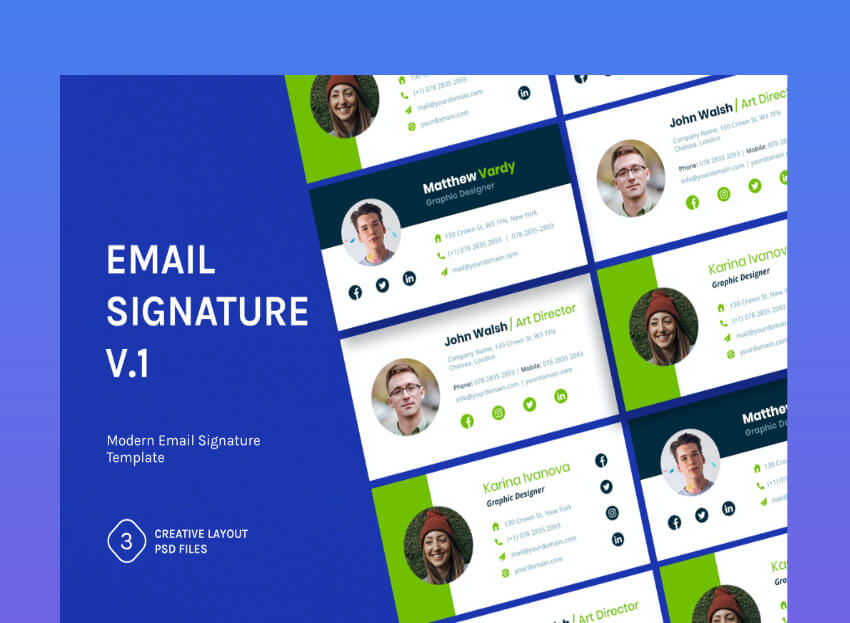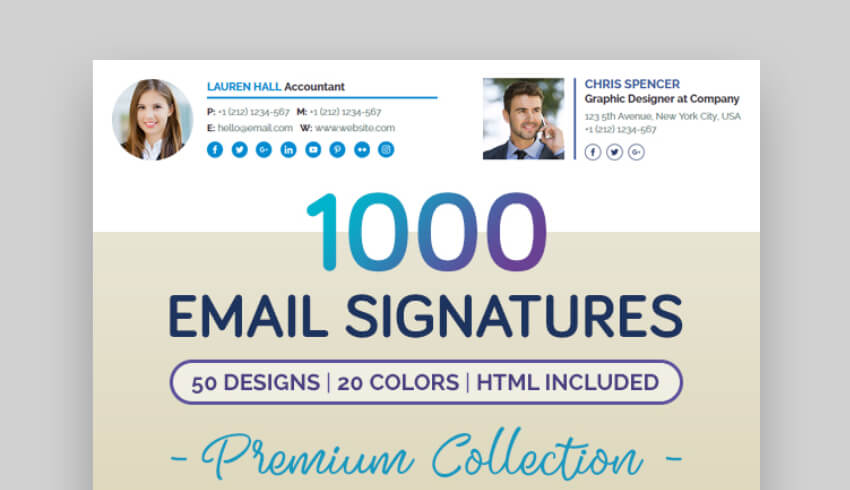Envato Tuts+ Tutorials |
- How to Make a Pool Party Flyer Template in Photoshop
- Not All Disabilities Are Visible: Improve Awareness and Access
- 18 Best Free Email Signature Templates (Download HTML + PSD for 2021)
| How to Make a Pool Party Flyer Template in Photoshop Posted: 03 Dec 2020 07:00 AM PST  In this tutorial, you will learn how to create a pool party flyer template in Photoshop. I will explain everything in so much detail that everyone can create the effect, even those who have just opened Photoshop for the first time. What You Will Learn in This Pool Party Flyer Template Tutorial |
| Not All Disabilities Are Visible: Improve Awareness and Access Posted: 03 Dec 2020 05:59 AM PST December 3rd is International Day of Persons with Disabilities. For 2020, " Not All Disabilities are Visible" has been chosen as a theme of this awareness campaign.  Do you know which of your employees or colleagues are disabled and which are not? Think again! Not all disabilities are visible. In this article, we'll discuss hidden or invisible disabilities. Discover what you can do to improve awareness, accessibility, and empathy in your workplace. What Is the International Day of Persons With Disabilities?The International Day of Persons with Disabilities was first recognized by the United Nations in 1992. The goal of this observance is to raise awareness. But this is more than simply recognizing that disabilities exist. Instead, the goal is to recognize the diversity of this global population and their rights.  Why is this so important? Consider that the World Health Organization estimates that around 15% of people across the entire globe live with a disability of some kind. This is an incredibly diverse population, originating from a variety of different cultures, genders, socio-economic backgrounds, and more. 15% of our world is over one billion people—these are our families, our friends, and our neighbors, whether they're next door or across an ocean. The Center of Disease Control and Prevention estimates that one in four people in the United States lives with reported disability as a part of their lives—this would be over 80 million people. In Europe, this estimate is six out of ten people. In Africa, the estimate is also around 80 million. This isn't taking into consideration the number of people who are unreported, either by choice or by other limitations. This is our world and our people—respect and wellness enrich all of our lives. This is why recognizing this population is both important and valuable. What Is an Invisible Disability?So, what is an invisible disability? Well, not all disabilities are visible outwardly, initially, or in ways one might assume. For example, you might not notice someone else has chronic pain, especially if you don't know them or they didn't share this information with you. The Invisible Disabilities Association explains that hidden or invisible disability also comes with the challenge of disbelief. Others can't see it, so they can't (or won't) understand. Misunderstandings and even insulting insinuations that one's faking or lying can be regular fears for people living with invisible illness and disability.  As an example, here's a short invisible disabilities list. Please note that this list isn't exhaustive or complete. It's not intended to exclude or elevate specific conditions, but rather to act as an introduction to a complicated and nuanced subject:
This sample invisible disabilities list illustrates the diversity of hidden disabilities. Here's a list of even more at the Disabled World site. Hidden disabilities can each present in a varied way, and certainly vary per individual. It isn't the mission of this article—or appropriate for your workplace—to diagnose, analyze, or come to conclusions about someone's wellness or health. Instead, we can listen and make ourselves more aware. Because invisible disabilities rarely outwardly apparent, it's very important to be informed and sensitive to the reality of this population and their wellness.  Awareness is important. If we understand that not all disabilities are visible this insight can help us craft a more inclusive, compassionate, and accessible workplace. Not knowing doesn't excuse offensive behavior nor does not seeing anything wrong. Instead, educating yourself on these topics can help further sensitivity. If you know of the subject of invisible illness and disability, you'll be better armed to respond in an empathetic and respectful manner. Awareness, Sensitivity, and InclusionThe words awareness, sensitivity, and inclusion have been used more and more in recent years. This is a wonderful thing—but what do they really mean, and how can you put them to use in a professional environment? These are more than popular keywords. They can be a huge benefit to your workplace if implemented properly. Here's a closer look at these three words: AwarenessConsider invisible disability awareness a good starting point. It's important to try to understand. A commitment to understanding is also a commitment to continued education. No single source is going to complete your understanding. Remain open to the idea that you don't understand everything. There's no finite end to learning. Knowledge is continual, and applying this knowledge is an adaptive process.  The experiences, health, and wellness of others may likely vary from yours, especially if you don't live with a disability. Don't speak authoritatively for others or assume that you know what's best, even if you do empathize or have something in common. An educated and aware perspective listens. It's okay not to understand everything—that's what learning is all about. Listening is an excellent way to learn and respond in an appropriate and respectful way. Even if your intentions are well meaning, you can end up in an offensive or destructive situation if you don't open your mind to learning and listening. It's especially important to listen to those most affected. SensitivityWorkplace sensitivity is all about making sure your professional environment, and everyone in it, is fair and welcoming. That's the kind of environment you'd want to work in, right? Think about it: wouldn't you want to feel welcome and accommodated? Offering this courtesy to others is not only respectful but will have a positive ripple effect in the workplace.  Here are some examples of sensitivity:
Sensitivity is a wonderful investment, because recognizes the beauty of a diverse team. Creativity, different points of view, different skillsets—these things can all bring amazing talent to your business and truly contribute to its success. If your workplace only nurtures one type of wellness, then you're potentially missing out on a lot of beautiful people out there. AccommodationsTake some time to think about what you offer your employees by way of accommodations. Consider this both broadly and in terms of diverse disabilities. Employment is often a large part of a person's life. Again, these concerns will likely apply to all your employees. Here are some questions to ask about your business:
 Disclosing a hidden disability can be a challenge for your employees. There may have been past circumstances that lead to embarrassment or intimidation to discuss this. There may be a fear of consequences. Work to create a welcoming environment of acceptance. Encourage flexibility, as well. Flexibility doesn't mean a lack of responsibility or a lack of productivity. Instead, flexibility helps with things like work life balance and wellness. These are vital parts of every employee's life, regardless of their position or background. In fact, the Harvard Business Review found that the majority of the US workforce values flexibility in the workplace. But less than half actually have it. In the same report, flexibility was even found to have an association with feeling valued versus workplace dissatisfaction. For those living with a hidden disability, this flexibility can make a significant impact in your employee's wellness and success. This is where Inclusion comes in. Inclusion can be defined as providing equal access to those who may not have had that access otherwise. Inclusion goes beyond one perspective and actively works to accommodate and include many perspectives—like learning variations, physical or mental disability, and more. Appreciating a Diverse PopulationPeople from all walks of life have hidden disabilities. From scientific fields to culinary arts, to home life, to teachers, entertainment, and more—this diverse population is involved with so many parts of our society, our cultures, and our world. A few examples of famous figures with hidden disabilities include:
But famous figures are a small percentage of this population. Many people with hidden disabilities choose not to disclose this information. Katherine Bouton lives with hearing loss. With an impressive history at the New York Times, Bouton openly discusses the reluctance and fear of speaking publicly about hidden disability. Many may have to face judgment, misunderstanding, negativity, and/or unwarranted criticism—as well as the anxiety and pressure of these confrontations. This is why understanding, compassion, and awareness are so important and so impactful.  More Information on Invisible Disability AwarenessThis article is just a piece of a much larger subject. You're encouraged to continue reading, exploring, and educating yourself on the subject of invisible disabilities. Here are some resources to help you continue:
There are also a number of articles on Envato Tuts+ that might help you further your insights. Check them out:
Invisible Disability Awareness Starts Today: But Keep Learning Year-RoundWhile December 3rd is International Day of Persons with Disabilities and we're encouraged to recognize invisible disabilities in 2020's observation, these topics are important all year round. Hidden or invisible illness awareness is a vital part of understanding and fostering a welcoming environment.  In closing, here's one of many wonderful invisible disabilities quotes. This one's from Understood.org, an organization that advocates for hidden disabilities such as ADHD and dyslexia:
Embrace your strength and the strength of your employees, your community, by embracing workplace inclusion, sensitivity, and accessibility. Here's to an even brighter year for all in 2021 and every year to come. |
| 18 Best Free Email Signature Templates (Download HTML + PSD for 2021) Posted: 03 Dec 2020 05:55 AM PST The email signature area is an excellent place to promote your business and give recipients another way to interact with you. But with millions of emails sent and received daily, it's important to make sure your email signature gets attention.  That's where an email signature template comes in. A well-designed email signature template helps you share resources and information with recipients without having to design the look and feel of it yourself. In this guide, I'll share some of the best paid and free email signature templates you can use to make your emails more memorable and more effective. You'll also find attractive premium email signature templates on Envato Elements. There are also eye-catching premium responsive email signature templates on GraphicRiver. Best Premium Email Signature Templates on Envato Elements (With Unlimited Use)If you're looking for premium email signature templates, Envato Elements has a great offer you won't want to miss. Download as many of the best email signature templates as you want, all for one low price. .jpg) Wondering why it makes sense to use a premium template for your email signature? Here are a couple of good reasons:
That's why it makes sense to check out the premium email signature templates on Envato Elements. To find the perfect email signature template on Envato Elements, select Graphic Templates to the right on the on-screen search box. Type There are a lot of PSD and HTML email signature templates for you to choose from. When you find the right one, click Download, then you can start customizing your email signature straight away. .png) 5 Best Premium PSD/HTML Email Signature Templates From Envato Elements For 2021 |
| You are subscribed to email updates from Envato Tuts+ Tutorials. To stop receiving these emails, you may unsubscribe now. | Email delivery powered by Google |
| Google, 1600 Amphitheatre Parkway, Mountain View, CA 94043, United States | |


















































.png)

















.jpg)

.jpg)
.jpg)



































0 Comments: